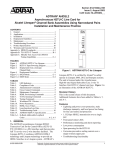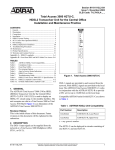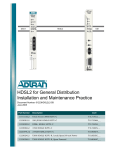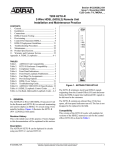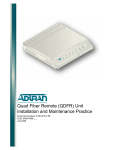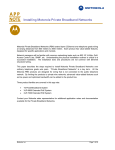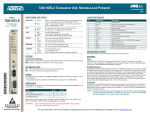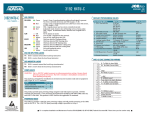Download ADTRAN HDSL2 Product specifications
Transcript
Section 61223006L1-5C
Issue 3, December 2003
CLEI Code: T1L79B9A_ _
T200 2-Wire HDSL2 Transceiver Unit for the Central Office
Installation and Maintenance Practice
CONTENTS
1. General...................................................................................... 1
2. Installation ................................................................................ 2
3. Connections .............................................................................. 6
4. HDSL2 System Testing ........................................................... 7
5. Control Port Operation.............................................................. 8
6. HDSL2 Deployment Guidelines............................................. 23
7. Troubleshooting Procedures ................................................... 24
8. Maintenance............................................................................ 25
9. Product Specifications ............................................................ 25
10. Warranty and Customer Service ............................................. 25
Appendix A. HDSL2 Loopbacks.............................................. A-1
H T UC
1223006L1
DSL
DSX/DS1
ALM
ESF/ SF
TABLES
B8ZS/ AMI
Table 1.
Table 2.
Table 3.
Table 4.
Table 5.
Table 6.
Table 7.
Table 8.
LBK
ADTRAN Unit Compatibility ........................................ 1
Compliance Codes .......................................................... 2
DIP Switch Options ........................................................ 3
Front Panel Indicators..................................................... 4
Provisioning Options ...................................................... 5
HDSL2 Loss Values ..................................................... 23
Troubleshooting Guide ................................................. 24
T200 H2TU-C Specifications ....................................... 26
TX
E
Q
RX
TX
M
O
N
RX
D
S
X
1. GENERAL
The ADTRAN T200 2-Wire HDSL2 Transceiver Unit
for the Central Office (T200 H2TU-C), P/N
1223006L1, is used to deploy an HDSL2 T1 circuit
using 2-wire metallic facilities. The unit occupies one
slot in a Type 200 or Type 400 enclosure. An illustration
of the T200 H2TU-C is shown in Figure 1.
Revision History
This third release of the documentation provides information regarding new hardware and firmware features
and capabilities.
Description
HDSL2 provides extended range to DS1/T1 transport
while providing spectral compatibility with ADSL and
other transport technologies. DSX1 signals are provided
to and received from the network while HDSL2 signals
are provided to the local loop. The ADTRAN T200
H2TU-C works in conjunction with the ADTRAN
H2TU-R (remote unit) to provide a DS1 service up to
12,000 feet on the local loop.
61223006L1-5C
Figure 1. ADTRAN T200 H2TU-C
Compatible versions of the ADTRAN H2TU-R are
listed in Table 1.
Table 1. ADTRAN Unit Compatibility
Unit Number
Description
122x026L1
T200 H2TU-R, Span Powered
122x024L1
T200 H2TU-R, Locally Powered
NOTE: x = any generic release number
Trademarks: Any brand names and product names included in this document are
trademarks, registered trademarks, or trade names of their respective holders.
1
Features
This release of the T200 H2TU-C provides new and/or
enhanced features as described below:
Enhanced Performance Monitoring
This unit features new firmware to retrieve and reset
Performance Data parameters.
TScan
This unit is equipped to support the TScan™ feature,
which provides data retrieval and diagnostic capabilities for remote management of DS1 circuits. TScan
allows provisioning, performance, and event history
information to be retrieved by the test center via the
Facility Data Link (FDL). In addition, TScan can be
used to determine the nature and location of faults on
DS1 trouble circuits. TScan is accessible only through
the remote test center.
Troubleshooting
New firmware detects the condition of the circuit and its
components and provides guidance in troubleshooting
any faults.
NOTE
Compliance
Table 2 shows the compliance codes for the ADTRAN
T200 H2TU-C. This product is intended for installation
in equipment with a Type “B” or “E” enclosure.
This product meets all requirements of Bellcore GR1089-CORE (Class A2), ANSI T1.418-2002 and is
NRTL listed to the applicable UL standards.
For implementation of TScan please contact
your local ADTRAN sales representative.
Table 2. Compliance Codes
Code
A patent-pending single-ended diagnostic routine
residing on a host server at the central test facility,
TScan issues commands and retrieves data via FDL
from the H2TU-C.
Input
Output
Power Code (PC)
F
C
Telecommunication Code (TC)
–
X
Installation Code (IC)
A
–
TScan performs the following functions (see Figure 2):
• Detection and location of an open, one or both
conductors
• Detection and location of a short between Tip and
Ring
• Detection and location of a ground fault from either
or both conductors
• Detection of foreign voltage
• H2TU-C Self Diagnostics
TScan allows operators to integrate these capabilities
across multiple computing platforms with existing
operating systems.
CO
C
C A U T I O N !
SUBJECT TO ELECTROSTATIC DAMAGE
OR DECREASE IN RELIABILITY.
HANDLING PRECAUTIONS REQUIRED.
After unpacking the T200 H2TU-C, inspect it for
damage. If damage has occurred, file a claim with the
carrier, then contact ADTRAN Customer Service.
Refer to the Warranty and Customer Service section for
further information.
Outside Plant Facilities
X
R
Open on either conductor
R
Open on both conductors
C
R
Short between T&R
C
R
Short to ground from either
or both conductors
C
2. INSTALLATION
X
X
Shipping Contents
The contents include the following items:
• T200 2-Wire HDSL2 Transceiver Unit for the
Central Office
• T200 2-Wire HDSL2 Transceiver Unit for the
Central Office Job Aid
Figure 2. TScan Diagnostic Capabilities
2
Issue 3, December 2003
61223006L1-5C
CAUTION
Electronic modules can be damaged by ESD.
When handling modules, wear an antistatic
discharge wrist strap to prevent damage to
electronic components. Place modules in
antistatic packing material when transporting
or storing. When working on modules, always
place them on an approved antistatic mat that is
electrically grounded.
Instructions for Installing the Module
To install the T200 2-Wire HDSL2 Transceiver Unit for
the Central Office, perform the following steps:
1. Hold the unit by the front panel while supporting
the bottom edge of the module.
2. Align the unit edges to fit in the lower and upper
guide grooves for the access module slot.
3. Slide the unit into the access module slot. Simultaneous thumb pressure at the top and at the bottom
of the unit will ensure that the module is firmly
seated against the backplane of the enclosure.
Provisioning DIP Switch Setting
A seven-position DIP switch is located on the printed
circuit board. The seven provisioning options controlled
by this switch may not be controlled via terminal
menus. The options are described in Table 3 below.
WARNING
Up to –200 VDC may be present on telecommunications wiring. Ensure chassis ground is
properly connected.
When the T200 H2TU-C first powers up it runs the
power up self-tests. Once the power up self-test is
complete the status LEDs will reflect the true state of
the hardware.
Table 3. DIP Switch Options
Switch Function
On
Off
Default
1. Line Build Out
133-266 ft.
0-133 ft.
Off
2. DS1 Signal
Unframed
Framed
Off
3. Frame Format
SF
ESF
Off
4. Line Code
AMI
B8ZS
Off
5. Loopback Time Out
Enabled
Disabled
Off
6. FT1 Loopback
Enabled
Disabled
Off
7. Span Power
Disabled
Enabled
Off
61223006L1-5C
Issue 3, December 2003
3
Front Panel LED Indicators
There are six front panel mounted status LED
indicators. Each indicator is described in Table 4.
Table 4. Front Panel Indicators
Front Panel
Name
DSL
H T UC
1223006L1
DSX/DS1
DSL
DSX/DS1
ALM
ESF/ SF
Indication
Description
Green
DSL sync, no errors currently detected, and signal margin ≥2 dB
Red
No DSL sync, errors being detected, or signal margin <2 dB
Green
DSX-1 is present and no errors currently detected
Red
No DSX-1 signal or signal is present with errors
OFF
No active alarm present
Red
Loss of DSX-1 signal to the unit
Yellow
Loss of DS1 signal to the remote
OFF
Unit is receiving Unframed data
Yellow
Unit is receiving ESF data
Green
Unit is receiving SF data
Yellow
Unit is receiving B8ZS line code data
Green
Unit is receiving AMI line code data
OFF
Unit is NOT in loopback
Yellow
Unit is in loopback (network and/or customer)
B8ZS/ AMI
ALM
LBK
TX
E
Q
RX
TX
M
O
N
RX
D
S
X
ESF/SF
B8ZS/AMI
LBK
4
Issue 3, December 2003
61223006L1-5C
Provisioning
The T200 H2TU-C DIP switch shown on Table 3 on
page 3 controls several of the provisioning settings.
Otherwise, configuration is performed via software
discussed in the Control Port Operation section of this
practice.
The provisioning settings can be viewed and manipulated through access to the firmware via the front panel
RS-232 port. Table 5 lists the available provisioning
options and their factory default settings.
Table 5. Provisioning Options
Provisioning Option
Option Settings
Default Settings
1. DSX-1 Line Build Out *
0-133 ft., 133-266 ft., 266-399 ft.,
399-533 ft., 533-655 ft.
0 to 133 ft.
2. DSX-1/DS1 Line Code *
B8ZS, AMI
B8ZS
3. DSX-1/DS1 Framing
SF, ESF, Unframed, Auto
ESF
4. Force Frame Conversion1
Disabled, Enabled
Disabled
5. Smartjack Loopback
Disabled, Enabled
Enabled
6. Loopback Time Out *
None, 120 Min
120 Minutes
7. Latching Loopback Mode2 *
T1 (Disabled), FT1 (Enabled)
T1 (Disabled)
8. DS1 Tx Level
0 dB, –7.5 dB, –15 dB
–7.5 dB
9. Span Power *
Enabled, Disabled
Enabled
10. Customer Loss Indicator3
AIS, Loopback, AIS/CI
AIS/CI
11. Performance Reporting Messages
None, SPRM, NPRM, AUTO (both)
AUTO
12. Loop Attenuation Alarm Threshold
0 (Disabled), 1-99 dB
30 dB
13. SNR Margin Alarm Threshold
0 (Disabled), 1-15 dB
04 dB
14. Remote Provisioning
Enabled, Disabled
Enabled
1 The forced frame format conversion (FFFC) mode sets the H2TU-C to ESF and the H2TU-R to SF. This mode should be used to force
SF (DS1 from customer) to ESF (DSX-1 to network) conversion in the absence of network-provided ESF framing.
2
Latching Loopback Mode
• T1 — When optioned for T1 mode, the unit does not respond to DDS Latching Loopback codes.
• FT1 (Fractional T1) — DDS Latching Loopback operation is supported. The H2TU-C units which are in the HDSL circuit are treated
as Identical Tandem Data ports and the HTU-R is treated as a different Tandem Data port.
NOTE: When operating in FT1 mode and during periods of T1 loss of signal, LOS, or T1 AIS from the customer CI, the HDSL
system will send in the network direction from the HTU-C a Fractional DS1 idle signal consisting of a repeating 7E (HEX) byte
payload within a framed/unframed T1 signal. In addition, when optioned for FT1 mode, the setting for Customer Loss Response is
ignored.
3
Customer Loss Indicator
• AIS — Send AIS to network upon T1 loss of signal or T1 AIS from customer
• LPBK — HTU-R initiates a network loopback upon T1 loss of signal or T1 AIS from customer
• AIS/CI — HTU-R sends customer disconnect indication upon loss of signal, loss of synchronization, or receipt of T1 AIS from
customer.
NOTE: The CI is generated by transmitting the framing received from the network while overwriting the payload with a repeating
pattern. For applications where the DS1 is Extended Superframe, the data link is overwritten with a Yellow Alarm that is interrupted
once every second by a 100 milli-second code burst of 7E (HEX).
* DIP Switch settings determine the settings for this option. Refer to Table 3 on page 3 for the proper position of the switch.
61223006L1-5C
Issue 3, December 2003
5
Span Powering
The default span powering option is ENABLED. The
T200 H2TU-C is capable of span powering the H2TU-R
by applying current to the local loop. From 10 to 150
mA of current is coupled onto the HDSL2 span to power
the H2TU-R when deployed (see Figure 3). The span
powering option can be set to DISABLED if the H2TUR is locally powered.
3. CONNECTIONS
The T200 H2TU-C occupies one card slot in a T200
enclosure. Power and alarm signals are provided to the
card through the backplane of the shelf. DSX1 and
HDSL2 loop signals are connected to the wirewrap pins
or mass termination (amphenol) shelf connectors corresponding to the slot the unit occupies. Figure 4 shows
the edge connection wiring for the T200 H2TU-C.
CAUTION
1
2
3
4
5
6
7
8
9
10
11
12
13
14
15
16
17
18
19
20
21
22
23
24
25
26
27
28
29
30
31
32
33
34
35
36
37
38
39
40
41
42
43
44
45
46
47
48
49
50
51
52
53
54
55
Disabling the span power removes all voltage
from the HDSL2 loop. This will result in an
absence of sealing current which could have an
adverse effect on circuit continuity over an
extended period of time.
SPAN CURRENT
TIP (+)
HDSL2
SPAN POWER
190V
RING (-)
Figure 3. H2TU-C Span Powering Diagram
H2TUC Alarm Outputs
The T200 H2TU-C contains an onboard fuse. If the fuse
opens, all front panel indicators will be off. This fuse is
not designed to be replaced in the field. A blown fuse
indicates that the card has malfunctioned and should be
replaced.
Chassis Ground
HDSL2 Tip
DSX RX Ring
Chassis Ground
DSX RX Tip
HDSL2 Ring
-48 VR
Chassis Ground
-48 VDC
DSX TX Tip
DSX TX Ring
Figure 4. H2TU-C Edge Connector Wiring
6
Issue 3, December 2003
61223006L1-5C
4. HDSL2 SYSTEM TESTING
The ADTRAN HDSL2 system provides the ability to
monitor the status and performance of the DSX-1
signals, DS1 signals, and HDSL2 loop signals. Detailed
performance monitoring is provided by the front panelmounted RS-232 Control Port. These features are
valuable in troubleshooting and isolating any system
level problems that may occur at installation or during
operation of the HDSL2 system. The following subsections describe additional testing features.
H2TU-C Bantam Jacks
The front panel of the H2TU-C contains both
monitoring and metallic splitting Bantam jacks. In
general, the monitoring jacks provide a non-intrusive
tap onto a signal line that permits the connection of test
equipment to monitor the characteristics of that signal.
For example, the DSX-1 monitor jack can be used to
connect to a bit error rate tester to monitor for synchronization, test patterns, etc. The metallic splitting jacks
provide an intrusive, signal interrupting access to the
line. It is very important to know the direction of the
access provided by a metallic splitting jack.
H2TU-C Loopbacks
The H2TUC responds to two different loopback
activation processes.
• First, loopbacks may be activated using the craft
interface. The Loopback Options Screen that
provides for the H2TU-C and H2TU-R loopbacks is
described in the Control Port Operation section of
this Practice.
• Second, the H2TU-C responds to the industry
standard patterns for HDSL loopbacks. A detailed
description of these loopback sequences is given in
Appendix A.
This unit contains smartloop technology. That is, the
unit will initiate the proper loopback regardless of how
the loopback control sequence is sent (framed or
unframed).
The loopback condition imposed in each case is a logic
level loopback at the point within the H2TU-C where
the DSX1 signal passes into the HDSL2 modulators.
Figure 6 depicts all of the loopback locations possible
with ADTRAN HDSL2 equipment.
Figure 5 illustrates the complete Bantam jack
arrangement and details for specific jacks.
H2TU-C Network-Side Loopback
AIS
LOCAL
LOOP
DSX-1
H2TU-C
DS1
X
H2TU-R
H2TU-R Network-Side Loopback or
H2TU-R NIU Loopback Smartjack
T1
DSX-1
AIS
R1
LOCAL
LOOP
DSX-1
DSX-1
MON
RX
H2TU-C
DS1
X
H2TU-R
H2TU-R Customer-Side Loopback
X
LOCAL
LOOP
AIS
H2TU-C
EQ
RX
HDSL2
H2TU-C
Data
Pump
DS1
H2TU-R
H2TU-C Customer-Side Loopback
X
Power
LOCAL
LOOP
AIS
H2TU-C
EQ
TX
DS1
H2TU-R
H2TU-R Bidirectional Loopback
LOCAL
LOOP
DSX-1
H2TU-C
DS1
H2TU-R
X = Signal Inactive
D = Data Sent
DSX-1
MON
TX
Figure 6. HDSL2 Loopbacks
T
DSX-1
R
Figure 5. H2TU-C Bantam Jack Arrangement
61223006L1-5C
In addition to network side loopbacks, the H2TU-C
provides customer side loopbacks initiated by using
either the terminal control port or in-band loop codes
(see Appendix A). In this mode, an AIS signal is transmitted to the network.
Issue 3, December 2003
7
5. CONTROL PORT OPERATION
The H2TU-C provides a DB-9 connector on the front
panel that supplies an RS-232 interface for connection
to a controlling terminal. The pinout of the DB-9 is
illustrated in Figure 7.
1
6
7
8
9
2
TXD (Transmit Data)
3
RXD (Receive Data)
4
5
SGN (Signal Ground)
Figure 7. RS-232 (DB-9) Pin Assignments
The terminal interface operates at data rates from 1.2
kbps to 19.2 kbps. The asynchronous data format is
fixed at 8 data bits, no parity, and 1 stop bit. The line
wrap feature of emulation programs should also be
disabled.
The H2TU-C supports two types of terminal emulation
modes. The Manual Update Mode is a dumb terminal
mode, allowing easy access to print screen and log files
commands. This mode also includes a “3 SPACES TO
UPDATE” message on the top of the terminal screen
(press the spacebar 3 times to update the screen).
The Real Time Update Mode is a VT100 terminal
mode. This mode enables all screen highlighting and
cursor placement. Print screen and log file commands
are not available in this mode.
The default terminal mode is Real-Time Update.
NOTE
If you are using a personal computer (PC) with
terminal emulation capability, be sure to
disable any power saving programs.
Otherwise, communication between the PC
and the HDSL2 unit may be disrupted,
resulting in misplaced characters or screen
time outs.
The screens illustrated in Figure 8 through Figure 31
are for an HDSL2 circuit deployed with the ADTRAN
HDSL2 technology. The circuit includes an H2TU-C
and H2TU-R. Other configurations are possible (for
example, an HDSL2 repeater from another vendor’s
equipment), and their displays will vary slightly from
those shown in this section.
A terminal session is initiated by entering multiple
spacebar characters, which are used by the H2TU-C to
determine the speed of the terminal. Once the speed has
been determined, the ADTRAN HDSL2 Main Menu is
displayed from which the various OAM&P (Operation,
Administrative, Maintenance, and Provisioning)
screens may be accessed (Figure 8). To display a
particular screen from the menu, press the number key
associated with the screen title and then press the ENTER
key.
Circuit ID:
12/01/03 09:29:45
Adtran HDSL2 Main Menu
1.
2.
3.
4.
5.
6.
7.
8.
9.
10.
11.
12.
13.
HDSL2 Unit Information
Provisioning
Span Status
Loopbacks and Test
Performance History
Scratch Pad, Ckt ID, Time/Date
Terminal Modes
Alarm History
Event History
System PM/Screen Report
Clear PM and Alarm Histories
Troubleshooting
Virtual Terminal Control
Selection:
Figure 8. ADTRAN HDSL2 Main Menu
8
Issue 3, December 2003
61223006L1-5C
The Unit Information Screen (Figure 9) provides
detailed product information on each component in the
HDSL2 circuit. ADRAN Technical Support contact
numbers are also available from the Unit Information
Screen.
The Provisioning Screen (Figure 10) displays current
provisioning settings for the HDSL2 circuit. Options
that can be changed from this screen are labeled with a
number (for example, “1” for DSX-1 Line Build Out). To
change a particular option setting, select the appropriate
number and a new menu will appear with a list of the
available settings. To return to the Main Menu, press
<ESCAPE>. To re-deploy this unit, press D which will
restore the factory default settings to those shown in
Table 5.
Circuit ID:
12/01/03 09:29:56
Press ESC to return to previous menu
ADTRAN
901 Explorer Boulevard
Huntsville, Alabama 35806-2807
--------------------- For Information or Technical Support -------------------Support Hours ( Normal 7am - 7pm CST, Emergency 7 days x 24 hours )
Phone: 800.726.8663 / 888.873.HDSL Fax: 256.963.6217 Internet: www.adtran.com
------------------------------------------------------------------------------ADTN
P/N:
S/N:
CLEI:
Manf:
Ver:
H2TU-C
1223006L1
123456789
T1L79B9AAA
11/01/2003
A01
ADTN
P/N:
S/N:
CLEI:
Manf:
Ver:
H2TU-R
1223026L1
123456789
T1L75ERAAA
11/01/2003
A01
Figure 9. ADTRAN Information Screen
Circuit ID:
12/01/03 09:40:10
Press ESC to return to previous menu
Provisioning
1.
2.
3.
4.
5.
6.
7.
8.
9.
10.
11.
12.
13.
14.
D.
DSX-1 Line Buildout
=
DSX-1/DS1 Line Code
=
DSX-1/DS1 Framing
=
Forced Frame Conversion =
Smartjack Loopback
=
Loopback Timeout
=
Latching Loopback Mode =
DS1 TX Level
=
Span Power
=
Customer Loss Indicator =
PRM Setting
=
Loop Atten Alarm Thres =
SNR Margin Alarm Thres =
Remote Provisioning
=
Restore Factory Defaults
*0-133 feet
*B8ZS
ESF
Disabled
Enabled
*120 Min
*T1 (Disabled)
-7.5 dB
*Enabled
AIS / CI
AUTO
30dB
04dB
Enabled
* - Option can only be provisioned by card switches.
Selection:
Figure 10. Provisioning Screen
61223006L1-5C
Issue 3, December 2003
9
The Span Status Screen (Figure 11) provides quick
access to status information for each HDSL2 receiver in
the circuit.
The Status Screen Legend (Figure 12) provides a
description of the messages that are used on the Status
screens.
Circuit ID:
12/01/03 09:44:39
Press ESC to return to previous menu
Span Status Screen
ATTEN
______ <-00dB->
______
|H2TUC |
|H2TUR |
--LOS->|
|
|
|------>
|
|
|
|
NET
|
|<--------->|
|
CUST
|
|17dB
17dB|
|
<------|
| MARGIN
|
|<-LOS-DSX-1 |______|
|______|
DS1
1.
2.
Legend
Detailed Status
Selection:
Figure 11. Span Status Screen
Press ESC to return to previous menu
STATUS SCREEN LEGEND
Alarm
LOS
LOF
RAI
AIS
Loop Attenuation
______
<---------- 25dB ------------>
______
|H2TUC |
|H2TUR |
<------|
|
|
|------>
|
|
|
|
|
|
|
|
|
|<---------------------------------->|
|
|
|9dB
8dB|
|
|
| |
| |
|
------>|
| Signal Margin
| |
|<-----|______| above 10e-7 BER
| |______|
for H2TUC Receiver
|
Signal Margin
above 10e-7 BER
Indicators:
Error Indicators:
for H2TUR Receiver
= Loss of Signal
ES = Errored Second
= Loss of Frame Sync
SES = Severely Errored Second
= Yellow Alarm
UAS = Unavailable Second
= Blue Alarm
Figure 12. Status Screen Legend
10
Issue 3, December 2003
61223006L1-5C
The Detailed Status selection from the Span Status
Screen menu (Figure 13) displays the T1 and HDSL2
status for each receiver point.
Circuit ID:
12/01/03 09:45:49
Press ESC to return to previous menu
Detailed HDSL2 and T1 Status
HDSL2 RECEIVER DATA
H2TU-C
H2TU-R
-------MARGIN(CUR/MIN/MAX): 17/00/17
ATTEN(CUR/MAX): 00/00
ES 15MIN:
000
SES 15MIN:
000
UAS 15MIN:
000
FRAMING:
LINE CODE:
ES-P/ES-L:
SES-P/SES-L:
UAS-P/UAS-L:
ALARMS:
-------17/00/17
00/00
000
000
000
T1 RECEIVER DATA
DSX-1
DS1
------------UNFR
UNFR
AMI
AMI
000/050
000/049
000/050
000/049
000/050
000/049
RED
RED
1. Zero Registers
2. Restart Min/Max
Selection:
Figure 13. Detailed Status Screen
61223006L1-5C
Issue 3, December 2003
11
The Loopback and Test Commands screen (Figure 14)
provides the user with the ability to evoke or terminate
all available HDSL2 loopbacks. Each HDSL2 circuit
component can be looped toward the network or
customer from this screen. Unit self tests can also be
initiated from this screen. A Loop Down ALL Units
command is available in lieu of the Self-Test option
when any loopback is active.
The Performance History Screens, illustrated in Figure
15, Figure 16, and Figure 17, display the historical
HDSL2 and T1 performance data in several different
registers. At each 15-minute interval, the performance
information is transferred to the previous 15-minute
performance data register. This unit stores performance
data in 15-minute increments for the last 24-hour
period.
Circuit ID:
12/01/03 09:47:04
Press ESC to return to previous menu
Loopback and Test Commands
______
______
|H2TUC |
|H2TUR |
------>|
|
|
|------>
|
|
|
|
NET
|
|<--------->|
|
CUST
|
|
|
|
<------|
|
|
|<-----DSX-1 |______|
|______|
DS1
1.
2.
3.
4.
5.
Run Self Tests
H2TU-C Loopup Network
H2TU-C Loopup Customer
H2TU-R Loopup Network
H2TU-R Loopup Customer
Selection:
Figure 14. Loopback and Test Commands Screen
Circuit ID:
12/01/03 09:51:05
Press ESC to return to previous menu
Menu
1.
2.
3.
4.
5.
6.
7.
8.
9.
10.
11.
Definitions
Reset Data
15 Min Data
60 Min Data
24 Hr Data
Line Data
Path Data
H2TUC DSX-1
H2TUC LOOP
H2TUR LOOP
H2TUR DS1
15 Minute H2TUC DSX-1 Performance Data
ES-L
001
-------------------------
SES-L UAS-L PDVS-L B8ZS-L CV-L
001
001
000
000
00000
09:45
------------09:30
------------09:15
------------09:00
------------08:45
------------08:30
------------08:15
------------08:00
------------07:45
------------07:30
------------07:15
------------07:00
------------___
___
--8>| C |
| R |--->
|
|<-9---------------10>|
|
<---|___|
|___|<-11
Selection:
Figure 15. Performance History, 15-Minute Line Data
12
Issue 3, December 2003
61223006L1-5C
Additionally, some units store up to 48 hours worth of
60-minute interval data. At each 24-hour interval, the
performance data is transferred into the previous 24hour performance data registers. This unit stores up to
31 days of 24-hour interval data.
Select a module and interface to view the corresponding
performance data. Line (L) and Path (P) can be viewed.
Circuit ID:
12/01/03 09:59:45
Press ESC to return to previous menu
Menu
1.
2.
3.
4.
5.
6.
7.
8.
9.
10.
11.
Definitions
Reset Data
15 Min Data
60 Min Data
24 Hr Data
Line Data
Path Data
H2TUC DSX-1
H2TUC LOOP
H2TUR LOOP
H2TUR DS1
60 Minute H2TUC DSX-1 Performance Data
ES-P SES-P UAS-P SAS-P ES-PFE CV-P
0000 0000 0000 0000 0000
00000
12/01 09:00 ---- ---- ---- ---- -------12/01 08:00 ---- ---- ---- ---- -------12/01 07:00 ---- ---- ---- ---- -------12/01 06:00 ---- ---- ---- ---- -------12/01 05:00 ---- ---- ---- ---- -------12/01 04:00 ---- ---- ---- ---- -------12/01 03:00 ---- ---- ---- ---- -------12/01 02:00 ---- ---- ---- ---- -------12/01 01:00 ---- ---- ---- ---- -------12/01 00:00 ---- ---- ---- ---- -------11/30 23:00 ---- ---- ---- ---- -------11/30 22:00 ---- ---- ---- ---- -------___
___
--8>| C |
| R |--->
|
|<-9---------------10>|
|
<---|___|
|___|<-11
Selection:
Figure 16. Performance History, 60-Minute Path Data
Circuit ID:
12/01/03 10:01:08
Press ESC to return to previous menu
Menu
1.
2.
3.
4.
5.
6.
7.
8.
9.
10.
11.
Definitions
Reset Data
15 Min Data
60 Min Data
24 Hr Data
Line Data
Path Data
H2TUC DSX-1
H2TUC LOOP
H2TUR LOOP
H2TUR DS1
24 Hour H2TUC DSX-1 Performance Data
11/30
11/29
11/28
11/27
11/26
11/25
11/24
11/23
11/22
11/21
ES-L
00000
-----------------------------------------
SES-L
00000
-----------------------------------------
UAS-L
00000
-----------------------------------------
PDVS-L
00000
-----------------------------------------
B8ZS-L
00000
-----------------------------------------
CV-L
0000000
-------------------------------------------------------------
___
___
--8>| C |
| R |--->
|
|<-9---------------10>|
|
<---|___|
|___|<-11
Selection:
Figure 17. Performance History, 24-Hour DSX-1 Data
61223006L1-5C
Issue 3, December 2003
13
Abbreviations used in the Performance Data screens are
defined in the Data Definitions screens (Figure 18 and
Figure 19).
Circuit ID:
12/01/03 10:04:08
Press ESC to return to previous menu
Performance Data Definitions
H2TUC, H2TUR, and H2R LOOP Related:
ES-L
Errored Seconds
SES-L
Severely Errored Seconds
UAS-L
Unavailable Seconds
HDSL2 Framing
CRC>=1 or LOSW>=1
CRC>=50 or LOSW>=1
>10 cont. SES-Ls
DS1 and DSX-1 Line Related:
ES-L
Errored Seconds
SES-L
Severely Errored Seconds
UAS-L
Unavailable Seconds
PDVS-L Pulse Density Violation Secs
B8ZS-L B8ZS Seconds
CV-L
Code Violation Count
Superframe and Extended Superframe
(BPV+EXZ)>=1 or LOS>= 1
(BPV+EXZ)>=1544 or LOS>=1
>10 cont. SES-Ls
EXZ>=1; >7 zeros if B8ZS, >15 if AMI
B8ZS coded signal received
(BPV+EXZ) count
NOTE: Reverse video indicates invalid data due to a terminal restart (or power
cycle), a data register reset, or a system date or time change.
N.
P.
Next
Previous
Selection:
Figure 18. Performance Data Definitions, Loop
Circuit ID:
12/01/03 10:04:40
Press ESC to return to previous menu
Performance Data Definitions
DS1 and DSX-1 Path Related:
ES-P
Errored Seconds
SES-P
Severely Errored Seconds
UAS-P
SAS-P
ES-PFE
Unavailable Seconds
SEF/AIS Seconds
Far End Errored Seconds
CV-P
Code Violation Count
Superframe
FE>=1 or
SEF>=1 or AIS>=1
FE>=8 or
SEF>=1 or AIS>=1
>10 cont. SES-Ps
SEF>=1 or AIS>=1
n/a
FE count
Extended Superframe
CRC>=1 or
SEF>=1 or AIS>=1
CRC>=320 or
SEF>=1 or AIS>=1
>10 cont. SES-Ps
SEF>=1 or AIS>=1
PRM bits G1-G6,SE,
or SL=1, or RAI
CRC error count
NOTE: Under a UAS-P condition, ES-P and SES-P counts are inhibited.
Under a SES-L or SES-P condition, the respective CV-L or CV-P count is
inhibited.
P.
Previous
Selection:
Figure 19. Performance Data Definitions, Path
14
Issue 3, December 2003
61223006L1-5C
The Scratch Pad, Circuit ID and Date/Time screen
provides a logging medium for circuit information
(Figure 20).
The Scratch Pad is available for circuit-specific notes
and can hold 50 alphanumeric characters in any combination.
The circuit ID can be any alphanumeric string up to 25
characters in length.
The time should be entered using military time. (For
example, enter 3:15 p.m. as “151500”.) The date should
be entered in the MMDDYY format. (For example,
enter January 02, 2003, as “010203”.)
Circuit ID:
12/01/03 10:15:45
Press ESC to return to previous menu
Current Scratch Pad:
New Scratch Pad =
New Circuit ID =
New Date =
New Time =
/
:
/
:
(MM/DD/YY)
(HH:MM:SS)
Press TAB to skip to next entry field.
Figure 20. Scratch Pad and Circuit ID Screen
61223006L1-5C
Issue 3, December 2003
15
This unit includes two terminal emulation modes. The
desired terminal mode can be selected from the
Terminal Modes Screen, illustrated in Figure 21.
Additionally, pressing CTRL+T while on any screen can
toggle the two terminal modes.
The Manual Update Mode allows the user to manually
update the screens. This mode supports efficient print
screen and log file utilities for storage of key provisioning parameters, alarm or performance history and
current system status. “3 SPACES TO UPDATE”
appears at the top of each screen. By pressing the
spacebar three times, the screen will be refreshed and
will reflect the most current circuit conditions and
provisioning options.
The second terminal emulation mode is the Real Time
Update Mode (VT100). This mode provides real time
updating of HDSL2 circuit conditions and provisioning
options as changes occur. The default mode is Real
Time Update.
Circuit ID:
12/01/03 10:30:45
Press ESC to return to previous menu
TERMINAL MODES MENU
MANUAL UPDATE MODE:
* You can print or log screens
* No text is highlighted
* "3 SPACES TO UPDATE" appears at the top of each screen,
reminding you to press the spacebar 3 times to update the screen
* There is a delay between screen changes & updates
* After 30 min. of no interaction, a new baud rate search is begun
* Ignores input until screen is finished printing.
REAL-TIME UPDATE MODE:
*
*
*
*
Faster of the two modes
You cannot print screens to a log file
Highlighting is enabled
Recommended for daily operation
Press CTRL+T to toggle update modes on any screen.
Figure 21. Terminal Mode Screen
16
Issue 3, December 2003
61223006L1-5C
The Alarm History screens are divided into three
separate screens: T1 Alarm History (Figure 22), HDSL2
Span History (Figure 23), and HDSL2 History (Figure
24).
T1 Alarm History screen (Figure 22) displays:
HDSL2 Span History screen (Figure 23) displays:
• Loss of Sync for each HDSL2 receiver
• Margin Threshold Alarm for each HDSL2 receiver
• Attenuation Threshold Alarm for each HDSL2
receiver
• DSX-1/DS1 Red Alarm
• DSX-1/DS1 Yellow Alarm
• DSX-1/DS1 Blue Alarm
Circuit ID:
12/01/03 10:42:53
Press ESC to return to previous menu
T1 Alarm History
LOCATION
ALARM
FIRST
LAST
CURRENT
COUNT
-------------------------------------------------------------------------------H2TU-C
RED(LOS/LOF) 01/01/00 00:00:04
01/01/00 00:00:04
Alarm
001
(DSX-1) YELLOW(RAI)
OK
000
BLUE(AIS)
OK
000
H2TU-R
(DS1)
RED(LOS/LOF) 01/01/00
YELLOW(RAI)
BLUE(AIS)
00:01:22
01/01/00
00:01:22
Alarm
OK
OK
001
000
000
-------------------------------------------------------------------------------1. T1 Alarm
2. HDSL2 Span
3. Facility Alarm C. Clear T1 Alarm
Selection:
Figure 22. T1 Alarm History Screen
Circuit ID:
12/01/03 10:44:11
Press ESC to return to previous menu
HDSL2 Span History
LOCATION
ALARM
FIRST
LAST
CURRENT
COUNT
-------------------------------------------------------------------------------SPAN 1
LOOP HLOS
OK
000
H2TU-C
H2TU-R
MRGN
MRGN
OK
OK
000
000
H2TU-C
H2TU-R
ATTN
ATTN
OK
OK
000
000
-------------------------------------------------------------------------------1. T1 Alarm
2. HDSL2 Span
3. Facility Alarm C. Clear HDSL2 Span
Selection:
Figure 23. HDSL2 Span History Screen
61223006L1-5C
Issue 3, December 2003
17
The Facility Alarm History screen (Figure 24) displays:
•
•
•
•
DC Open
Over-current (short)
Ground fault
Power cycle
Circuit ID:
12/01/03 10:46:50
Press ESC to return to previous menu
Facility Alarm History
LOCATION
ALARM
FIRST
LAST
CURRENT
COUNT
-------------------------------------------------------------------------------FACILITY DC OPEN
OK
000
FACILITY SHORT
OK
000
FACILITY GROUND FAULT
OK
000
H2TU-C
POWER CYCLE
01/01/00
00:00:02
01/01/00
00:00:02
OK
001
-------------------------------------------------------------------------------1. T1 Alarm
2. HDSL2 Span
3. Facility Alarm C. Clear Facility Alarm
Selection:
Figure 24. HDSL2 Facility Alarm History Screen
18
Issue 3, December 2003
61223006L1-5C
The Event History screen (Figure 25) provides a log
history of HDSL2 circuit events. The following is a list
of possible events:
•
•
•
•
•
•
•
Circuit ID Change
DS1 Transmit Level Option Change
DSX/DS1 Alarm Type Active/Inactive
DSX-1 Line Build Out Option Change
Element Network/Customer Loop up/Loop down
Event Log Reset
External Alarm Blocking Change
•
•
•
•
•
•
•
•
•
Framing Option Change
H2TU-C/H2TU-R Powered Up
HDSL/T1 PM Registers Reset
Line Code Option Change
Loopback Time Out Option Change
NIU Loopback Option Change
Span Power Option Change
Time/Date Changed From/To
Loop Segment XX In/out of Sync
Circuit ID:
12/01/03 10:44:11
Press ESC to return to previous menu
CIRCUIT ID:
Num
Description of Event
Date
Time
Source
------------------------------------------------------------------------1.
2.
3.
4.
5.
H2TU-C
H2TU-C
H2TU-C
H2TU-C
H2TU-C
Powered Up
Network Loop Up Request
Network Loop Down Request
Customer Loop Up Request
Customer Loop Down Request
11/23/03
11/24/03
11/24/03
11/24/03
11/24/03
15:34:00
08:53:11
08:53:21
08:53:32
08:53:41
H2TU-C
H2TU-C
H2TU-C
H2TU-C
H2TU-C
Page Number:
1/ 1
Number of Events:
8
------------------------------------------------------'P' - Previous Page 'H' - Home
'R' - Reset Events
'N' - Next Page
'E' - End
Selection:
Figure 25. Event History Screen
61223006L1-5C
Issue 3, December 2003
19
The System PM/Screen Report option (Figure 26)
offers four types of reports on performance monitoring.
Selecting a report type will then display all the reports
for that category on the screen at once, which is more
efficient than stepping through the menus individually.
1.
2.
3.
4.
5.
6.
7.
8.
9.
10.
11.
12.
13.
The Clear PM and Alarm Histories screen (Figure 27)
initializes data from performance monitoring and alarm
histories. Selecting this option from the Main Menu
displays a verification prompt, “(Y/N)?” Pressing N
will display the message, “Performance and History
data NOT cleared,” and returns to the Main Menu.
HDSL2 Unit Information
Provisioning
Span Status
Loopbacks and Test
Performance History
Scratch Pad, Ckt ID, Time/Date
Terminal Modes
Alarm History
Event History
System PM/Screen Report
Clear PM and Alarm Histories
Troubleshooting
Virtual Terminal Control
Selection: 10
Enable data logging now.
Select Report Type or Press Escape to cancel:
1) Full System/History Report
2) Current Status Report
3) System Configuration Report
4) Alarm/Event History
Figure 26. System PM/Screen Report Option
Circuit ID:
12/01/03 10:29:45
Adtran HDSL2 Main Menu
1.
2.
3.
4.
5.
6.
7.
8.
9.
10.
11.
12.
13.
HDSL2 Unit Information
Provisioning
Span Status
Loopbacks and Test
Performance History
Scratch Pad, Ckt ID, Time/Date
Terminal Modes
Alarm History
Event History
System PM/Screen Report
Clear PM and Alarm Histories
Troubleshooting
Virtual Terminal Control
This will clear the PM, Alarm, Span Status, and
Troubleshooting Histories for all circuit elements.
Are you sure (Y/N)?
Selection: 11
Figure 27. Clear PM and Alarm Histories
20
Issue 3, December 2003
61223006L1-5C
Item 12 on the Main Menu displays the Troubleshooting
screen (Figure 28). Helpful ADTRAN contact information along with two menu items appear on the bottom
of this screen.
Selecting option 1 from the Troubleshooting screen
causes the H2TU-C to read the operational status of the
card and return Troubleshooting Guidance, or hints, as
to the probable cause of the trouble, as shown in
Figure 29.
Circuit ID:
12/01/03 10:29:45
Press ESC to return to previous menu
Troubleshooting
For HELP based on detected problems, select Troubleshooting Guidance from the
list below. If further assistance is needed, contact ADTRAN Tech Support.
Hours: Normal 7am - 7pm CST
Emergency 7 days x 24 hours
Phone: 800.726.8663 / 888.873.HDSL
Fax: 256.963.6217
1. Troubleshooting Guidance
2. General Information
Selection:
Figure 28. Troubleshooting Screen
Circuit ID:
12/01/03 10:29:45
Press ESC to return to previous menu
DSX-1 Loss of Signal (Red Alarm)
- Patch test set REC jack into H2TUC MON TX jack to verify integrity of
signal to the H2TUC from the network (verify test set in MON mode).
- If signal to H2TUC is missing, insert test set at DSX panel IN Jack connecting
toward H2TUC (to verify wiring between DSX and H2TUC shelf). Check H2TUC to
verify DSX-1 LOS alarm is cleared. This verifies TX(out) and RX(in) pairs are
not swapped.
- If signal from DSX OK, verify cross-connect wiring at DSX panel is turned over
(OUT to IN) and (IN to OUT).
-If DSX wiring OK, connect test set REC to the DSX MON, network side equipment,
to verify signal from network (verify test set to MON). If no signal,
troubleshoot office problems.
For Total Access cards verify the following:
- Provisioning>Network Source is configured correctly for Mux or DSX operation.
- Provisioning>Service State is not configured for OOS-Unassigned.
- Mux card is mapped correctly.
- Mux card is functioning correctly.
Figure 29. Troubleshooting Guidance
61223006L1-5C
Issue 3, December 2003
21
Selecting option 2 from the Troubleshooting screen
accesses the General Information Screen (Figure 30)
that summarizes the deployment guidelines necessary
to provision this HDSL2 circuit.
The Virtual Terminal Session Screen (Figure 31) allows
control of the Remote card provisioning from the
H2TU-C. Press 1 from this screen to begin a userinitiated session with the Remote card. When the
remote session is completed, Press CTRL+X to terminate
the session.
Circuit ID:
12/01/03 11:13:10
Press ESC to return to previous menu
HDSL2 Loop Guidelines for optimum operation
------------------------------------------Non-loaded cable pair
Single bridge tap < 2Kft
Total bridge taps < 2.5Kft
Bridge tap within 1000ft of transceiver may affect performance.
Impulse noise < 50dBrnF (F filter)
Wideband noise < 31dBrnF (f filter)
Power influence <= 80 dBrnC
Longitudinal Balance >= 60dB (If using Wideband test at 196 Khz >= 40dB)
Foreign DC Voltage (t-r,t-g,r-g) < 3VDC
Loop Resistance <= 775 ohms
Margin >= 6 dB
Attenuation <= 28 dB
Figure 30. General Information Screen
Circuit ID:
12/01/03 11:15:11
Press ESC to return to previous menu
Virtual Terminal Session: Inactive
Virtual Host: no
Virtual Terminal Control
1.
Log into H2TU-R
Selection:
Figure 31. Virtual Terminal Control Screen
22
Issue 3, December 2003
61223006L1-5C
6. HDSL2 DEPLOYMENT GUIDELINES
The ADTRAN HDSL2 system is designed to provide
DS1 based services over loops designed to comply with
carrier service area (CSA) guidelines. CSA deployment
guidelines are given below:
1. All loops are nonloaded only.
2. For loops with 26-AWG cable, the maximum loop
length including bridged tap lengths is 9 kft.
3. For loops with 24-AWG cable, the maximum loop
length including bridged tap lengths is 12 kft.
4. Any single bridged tap is limited to 2 kft.
5. Total bridged tap length is limited to 2.5 kft.
6. The total length of multigauge cable containing
26-AWG cable must not exceed the following:
• 12 - {(3*L26) / (9- LBTAP)} (in kft)
• L26 = Total length of 26-AWG cable
excluding bridged taps (in kft)
• LBTAP = Total length of all bridged taps (in kft)
These deployment criteria are summarized in the chart
shown in Figure 32.
WORKING LENGTH OF 24 GAUGE (OR COARSER) CABLE (KFT)
12
11
INVALID CABLE LENGTHS
Loop loss per kilofoot for standard wire gauges is
summarized in Table 6.
Table 6. HDSL2 Loss Values
Cable
Gauge
Cable
Type
68°F
Temperature
90°F
120°F
26
PIC
3.902
4.051
4.253
26
Pulp
4.030
4.179
4.381
24
PIC
2.863
2.957
3.083
24
Pulp
3.159
3.257
3.391
22
PIC
2.198
2.255
2.333
22
Pulp
2.483
2.545
2.629
19
PIC
1.551
1.587
1.634
19
Pulp
1.817
1.856
1.909
NOTE
These approximations are to be used as guidelines only and may vary slightly on different
loops. Adhering to the guidelines should
produce performance in excess of 10-7 BER.
10
An approximation for the maximum amount of
wideband noise as measured using an F filter on an
HDSL2 loop having 35 dB loss is < –47 dBrnF.
TOTAL
9
2.5
2.0
1.5
1.0
8
7
BRIDGED
TAP
LENGTH
(KFT)
An approximation for the maximum level of impulse
noise as measured using an F filter on an HDSL2 loop
having 35 dB loss is ≤–38 dBrnF.
0.5
0.0
6
For additional information on these and other
deployment issues, refer to HDSL Supplemental
Deployment Information, document number
61221HDSLL1-10.
5
4
3
2
NOTE
VALID CABLE LENGTHS
1
0
0
1
2
3
4
5
6
7
8
9
These approximations are to be used as guidelines only and may vary slightly on different
loops. Adhering to the guidelines should
produce performance in excess of 10-7BER.
WORKING LENGTH OF 26 GAUGE CABLE (KFT)
Figure 32. HDSL2 Deployment Guidelines
61223006L1-5C
Issue 3, December 2003
23
7. TROUBLESHOOTING PROCEDURES
Table 7 is a troubleshooting guide for the
T200 H2TU-C.
Table 7. Troubleshooting Guide
Condition
All Front Panel indicators are Off.
Solution
1. Verify that –48 VDC power is properly connected to the shelf.
2. Inspect the fuse to verify that it is not blown.
3. Insert the H2TU-C into a slot known to be in good working condition, and check the
LEDs.
4. If Steps 1 and 2 pass, but Step 3 fails, replace the H2TU-C.
DSL LED is Solid Red.
Loop has poor signal quality or loss of sync. Basic troubleshooting procedures
should identify a potential problem with the cable pair.
DSX/DS1 LED is Solid Red.
Errors are being taken on the DSX, DS1 or HDSL2 loop. The craft interface will
identify the source. BERT tests to the appropriate loopbacks should also reveal the
source of the problem.
Alarm LED is Solid Red.
Loss of DSX-1 signal to the unit.
Alarm LED is Yellow
If customer equipment is not installed, initiate an H2TU-R to Network Loopback and
perform BERT test. If this test fails, or the craft interface indicates a loss of sync,
then there is a potential problem with the cable pair that should be identified through
basic troubleshooting procedures.
24
Issue 3, December 2003
61223006L1-5C
8. MAINTENANCE
The ADTRAN T200 H2TU-C requires no routine
maintenance. In case of equipment malfunction, use the
front panel bantam jack connectors to help locate the
source of the problem.
ADTRAN does not recommend that repairs be
performed in the field. Repair services may be obtained
by returning the defective unit to ADTRAN. Refer to
the Warranty and Customer Service section of this
Practice.
Refer to the following subsections for sales, support,
CAPS requests, or further information.
ADTRAN Sales
Pricing/Availability:
800-827-0807
ADTRAN Technical Support
Pre-Sales Applications/Post-Sales Technical
Assistance:
800-726-8663
9. PRODUCT SPECIFICATIONS
Product specifications are detailed in Table 8.
Standard hours: Monday - Friday, 7 a.m. - 7 p.m. CST
Emergency hours: 7 days/week, 24 hours/day
10. WARRANTY AND CUSTOMER SERVICE
ADTRAN will replace or repair this product within the
warranty period if it does not meet its published specifications or fails while in service. Warranty information
can be found at www.adtran.com/warranty.
ADTRAN Repair/CAPS
Return for Repair/Upgrade:
(256) 963-8722
U.S. and Canada customers can also receive a copy of
the warranty via ADTRAN’s toll-free faxback server at
877-457-5007.
• Request document 414 for the U.S. and Canada
Carrier Networks Equipment Warranty.
• Request document 901 for the U.S. and Canada
Enterprise Networks Equipment Warranty.
61223006L1-5C
Repair and Return Address
Contact Customer and Product Service (CAPS) prior to
returning equipment to ADTRAN.
ADTRAN, Inc.
CAPS Department
901 Explorer Boulevard
Huntsville, Alabama 35806-2807
Issue 3, December 2003
25
Table 8. T200 H2TU-C Specifications
Specification
Description
Loop Interface
Modulation Type
Mode
Number of Pairs
Bit Rate
Baud Rate
Service Range
Loop Loss
Bridged Taps
Performance
H2TU-C Tx Pwr (Data) Level
H2TU-C Tx Pwr (Activation) Level
Input Impedance
Maximum Loop Resistance
Return Loss
16-TC PAM
Full Duplex, Partially Overlapped, Echo Canceling
1
1.552 Mbps
517.333 k baud
Defined by Carrier Service Area Guidelines
35 dB maximum @ 196 kHz
Single Taps < 2 kft, Total Taps < 2.5 kft
Compliant with T1.418-2000 (HDSL2 Standard)
16.8 + 0.5 dBm (0 to 450 kHz)
16.6 + 0.5 dBm (0 to 450 kHz)
135 ohm
900 ohms per span
12 dB (50 kHz to 200 kHz)
Network Interface
DSX-1 Output Level
DSX-1 Line Build Out
DS1 Line Coding
DS1 Framing Format
0 dB, –7.5 dB (default), –15 dB
0-133 feet (default);
133-266 feet ABAM; 266-399 feet ABAM
399-533 feet ABAM; 533-655 feet ABAM
AMI, B8ZS (default)
Auto, SF, ESF (default), Unframed
Power
Tested with the ADTRAN H2TU-R (1223026L1).
Total Power
H2TU-C Power Dissipation
Span Power
Fusing
–48 VDC @ 160 mA with H2TU-R
4.0 watts with H2TU-R
–190 VDC (Internally Generated) Class A2 compliant, current
limited at 150 mA
1.00 A (on-board; not field-replaceable)
Clock
Clock Sources
Internal Clock Accuracy
DSX-1 Derived (with HDSL2 frame bit stuffing)
± 25 ppm, (exceeds Stratum 4). Meets T1.101 timing
requirements.
Tests
Diagnostics
Self-Test, Local Loopback (H2TU-C), Remote Loopback
(H2TU-R)
Physical
Dimensions
Weight
5.5 in. high x .7 in. wide x 6 in. deep
Less than 1 lb.
Environment
Temperature
Operating (Standard): –40°C to +70°C;
Storage: –40°C to +85°C
Compliance
UL Listed; Bellcore NEBS Level 3 (SR-3580); FCC 47CFR Part 15, Class A
Part Number
T200 2-Wire HDSL2 Transceiver Unit for the Central Office
26
1223006L1
Issue 3, December 2003
61223006L1-5C
Appendix A
HDSL2 Loopbacks
GENERAL
HDSL2 MAINTENANCE MODES
This appendix describes operation of the HDSL2
system with regard to detection of inband and ESF
facility data link loopback codes.
Upon deactivation of a loopback, the HDSL2 system
will synchronize automatically.
Loopback Process Description
In general, the loopback process for the HDSL2 system
elements is modeled on the corresponding DS1 system
process. Specifically, the H2TUC loopback is similar to
an Intelligent Office Repeater loopback and the
H2TU-R loopbacks are similar to an in-line T1 Repeater
loopback.
In-band control code sequences are transmitted over the
DS1 link by either the unframed or overwrite method.
The HDSL2 elements respond to either method.
The unframed method produces periodic control
sequences and the normal DS1 framing bit is omitted.
The overwrite method produces periodic control
sequences. However, once per frame, the framing bit
overwrites one of the bits in the control sequence.
61223006L1-5C
The unit can detect the loopback activation or deactivation code sequence only if an error rate of 1E-03 or
better is present.
DDS Latching Loopback Operation
If the unit is optioned for FT1 mode, then DDS Latching
Loopback operation is supported as described in
Bellcore TA-TSY-000077, Issue 3, Section 5.1.3. The
H2TU-C in the HDSL2 circuit is treated as an Identical
Tandem Dataport and the H2TU-R is treated as a
Different Tandem Dataport. The H2TU-R will
establish a network loopback upon detection of standard
DDS NI-NEI/RPTR loopback sequence.
Loopback Control Codes
A summary of control sequences is given in Table A-1
and Table A-2.
NOTE
In all control code sequences presented, the
inband codes are shown leftmost bit transmitted first, and the ESF data link codes with
rightmost bit transmitted first.
A-1
Table A-1. HDSL2 Loopback Control Codes
Type
Source 1
Code 2,3
Name
Abbreviated
(N)
3in7
(1110000)
4in7
(1111000)
5in7
(1111100)
6in7
(1111110)
Loopback data from network toward network in the H2TU-R.
FF1E
(1111 1111 0001 1110)
3F1E
(0011 1111 0001 1110)
FF02
(1111 1111 0000 0010)
3F02
(0011 1111 0000 0010)
1in6
(100000)
FF48 (ESF-DL)
(1111 1111 0100 1000)
1in3
(100)
FF24 (ESF-DL)
(1111 1111 0010 0100)
Loopback data from network toward network at H2TU-C.
(N)
(C)
(C)
Wescom
(N)
(C)
(N)
(C)
(N)
(N)
(N/C)
(N/C)
Loopback data from network toward network in the H2TU-C.
Loopback data from customer toward customer in H2TU-R.
Loopback data from customer toward customer in H2TU-C.
Loopback data from customer toward customer at H2TU-C.
Loopback data from network toward network at H2TU-R.
Loopback data from customer toward customer at H2TU-R.
Loopback data from network toward network at H2TU-R.
Loopback data from network toward network at H2TU-R.
Loop down everything.
Loop down everything.
1 The Source column indicates from which side of the interface the control codes are sent. For example, an (N) indicates a network sourced code
while a (C) indicates a customer sourced code.
2 All codes are in-band unless labeled ESF-DL.
3 All codes listed above must be sent for a minimum of 5 seconds in order for them to be detected and acted upon.
A-2
Issue 3, December 2003
61223006L1-5C
Table A-2. In-Band Addressable Loopback Codes
(All codes listed below must be sent for a minimum of 5 seconds in order for them to be detected and acted upon.)
Function
Code
Source
Code and Response
Arm
11000
(2-in-5 pattern)
(N)
If the pattern is sent from the network, the units will arm, and the
H2TU-R will loop up if NIU Loopback is enabled.
Disarm
11100
(3-in-5 pattern)
(N/C)
The H2TU-C is removed from the armed state. If any of the units are
in loopback when the 11100 pattern is received, they will loop down.
The LBK LEDs will turn off on all units.
H2TU-C
Network
Loop Up
D3D3
(1101 0011 1101 0011)
(N)
If the units have been armed and no units are in loopback4, the H2TUC will loop up toward the network, 2 seconds of AIS (all ones) will be
sent, 5 seconds of data will pass, and then 231 bit errors will be
injected into the DSX-1 signal. As long as the pattern continues to be
sent, 231 errors will be injected every 20 seconds. When the pattern is
removed, the unit will remain in loopback. If the pattern is reinstated,
the injection of 231 bit errors will resume at 20-second intervals.
HRE
Network
Loop up
C741
(1100 0111 0100 0001)
(N)
If an HRE is present, the units have been armed, the HRE will loop up
towards the network, 2 seconds of AIS (all 1s) will be sent, 5 seconds
of data will pass, and then 10 bit errors will be injected into the DSX-1
signal. As long as the pattern continues to be sent, 10 bit errors will be
injected every 20 seconds. When the pattern is removed, the unit will
remain in loopback. If the pattern is reinstated, the injection of 10 bit
errors will resume at 20-second intervals.
HTU-R
Loop up
C742
(1100 0111 0100 0010)
(N)
When set from the network, an HTU-R network loopback is activated
and a 20-bit error confirmation is sent every 10 seconds.
Loop
down
9393
(1001 0011 1001 0011)
(N)
When sent from the network, all units currently in loopback will loop
down. Armed units will not disarm. In order to behave like a
smartjack, the H2TU-R will not loop down from a network loopback
in response to the 9393 pattern if NIU Loopback is enabled.
Loopback
Time Out
Override
D5D6
(1101 0101 1101 0110)
(N)
If the units are armed and this pattern is sent, the loopback time out
will be disabled. The time out option will be updated on the
Provisioning menu of the H2TU-R (viewable through the RS-232
port) to “None.” As long as the units remain armed, the time out will
remain disabled. When the units are disarmed, the loopback time out
will return to the value it had before the D5D6 code was sent. As long
as the pattern continues to be sent, errors are injected again every 20
seconds as follows:
H2TU-C 231 errors
H2TU-R
20 errors
Span
Power
Disable
6767
(0110 0111 0110 0111)
(N)
If the units are armed and this pattern is sent, the H2TU-C will
deactivate its span power supply, turning off the H2TU-R. As long as
the pattern continues to be sent, the span power supply will remain
disabled. When the pattern is no longer being sent, the H2TU-C will
reactivate its span power supply, turning the remote unit(s) on. All
units will retrain and return to the disarmed and unlooped state.
4
If smartjack is enabled, then the H2TU-R can be in network loopback when the H2TU-C loop-up codes are sent.
61223006L1-5C
Issue 3, December 2003
A-3
A-4
Issue 3, December 2003
61223006L1-5C






























